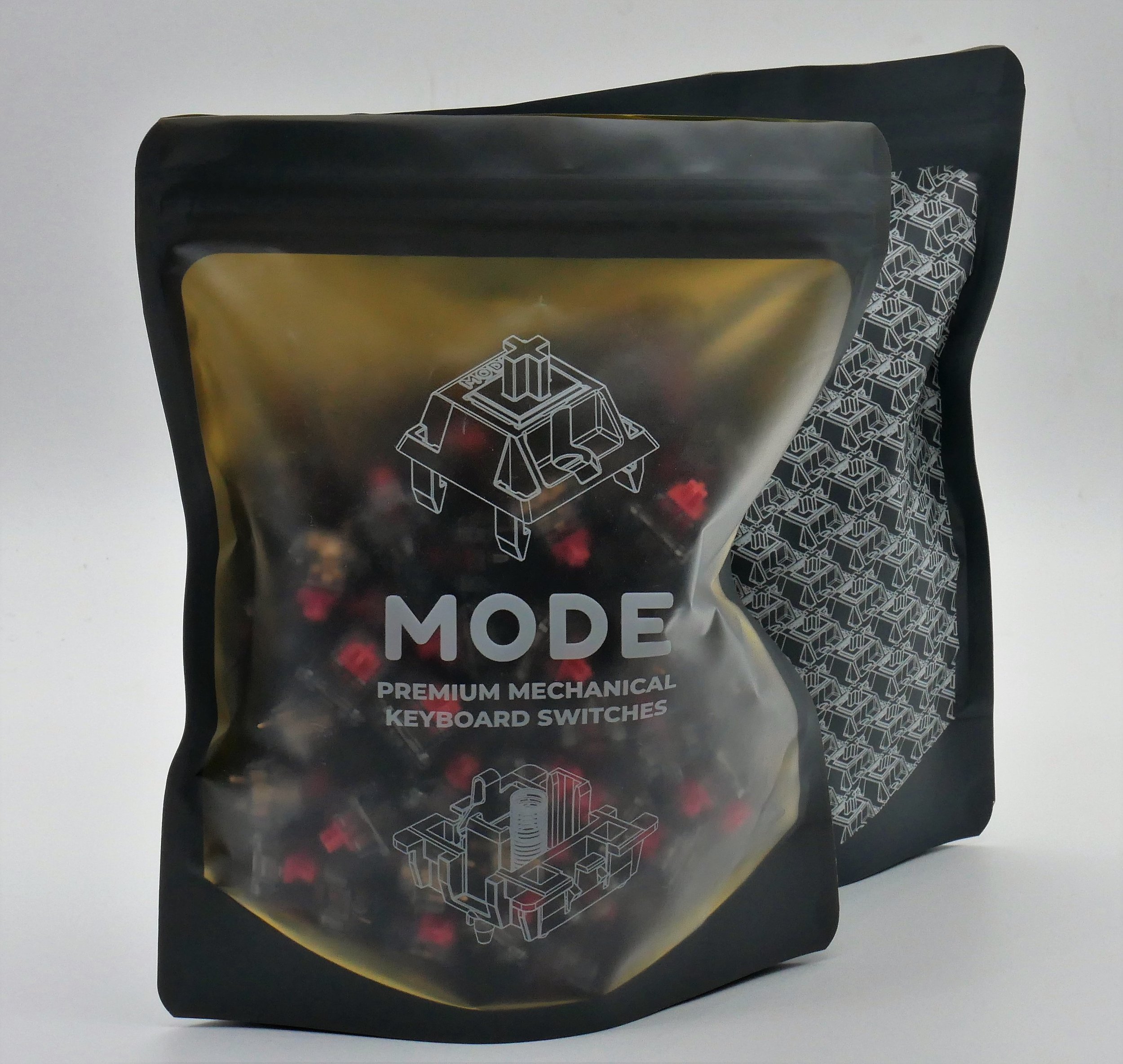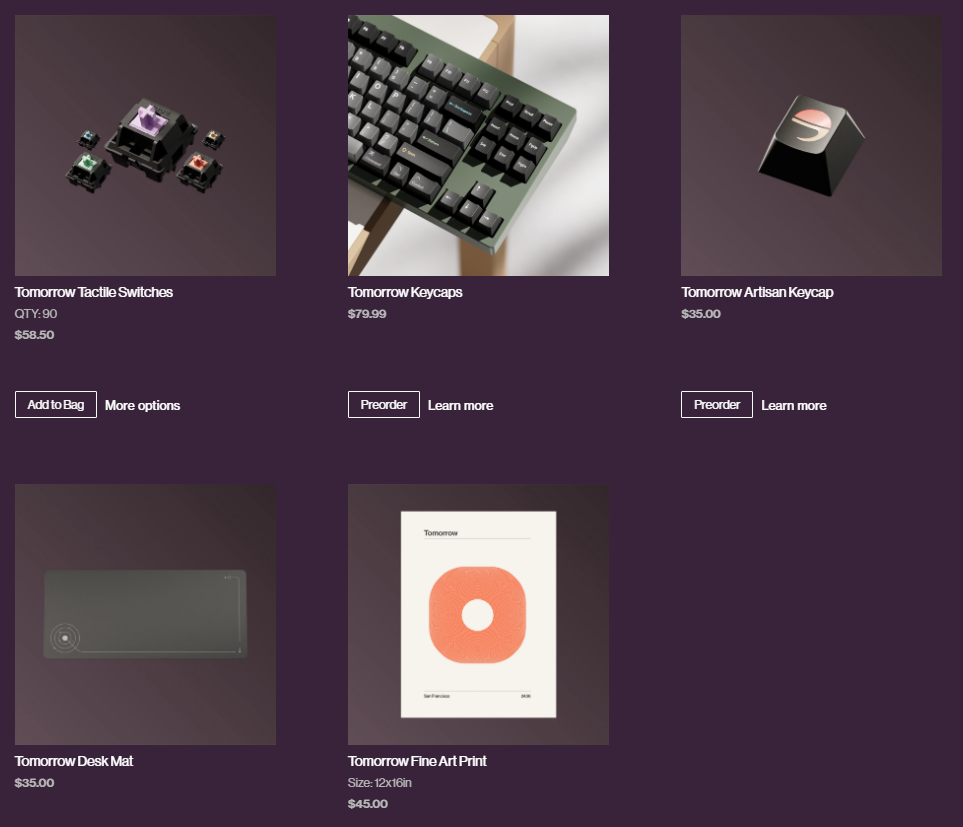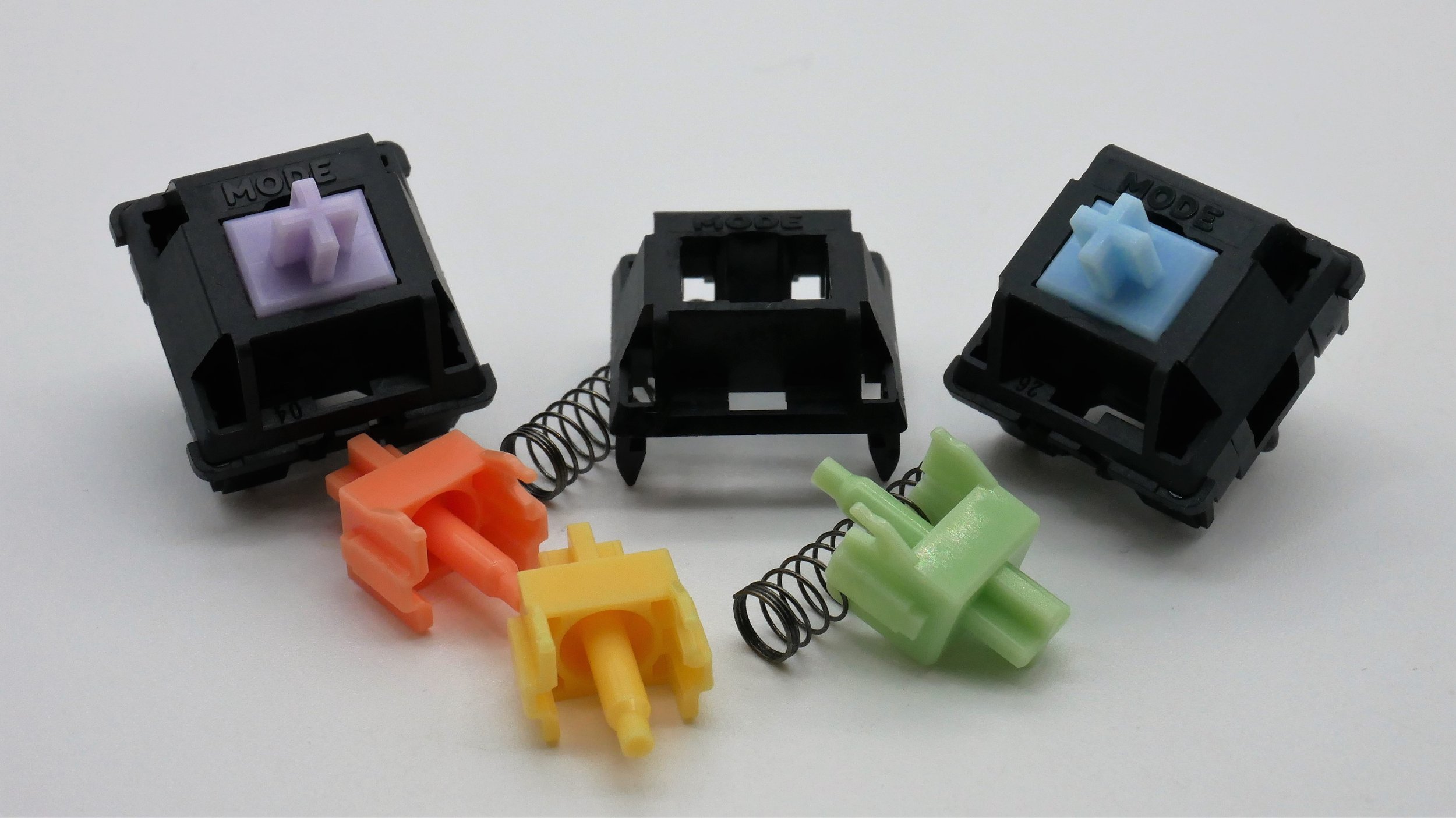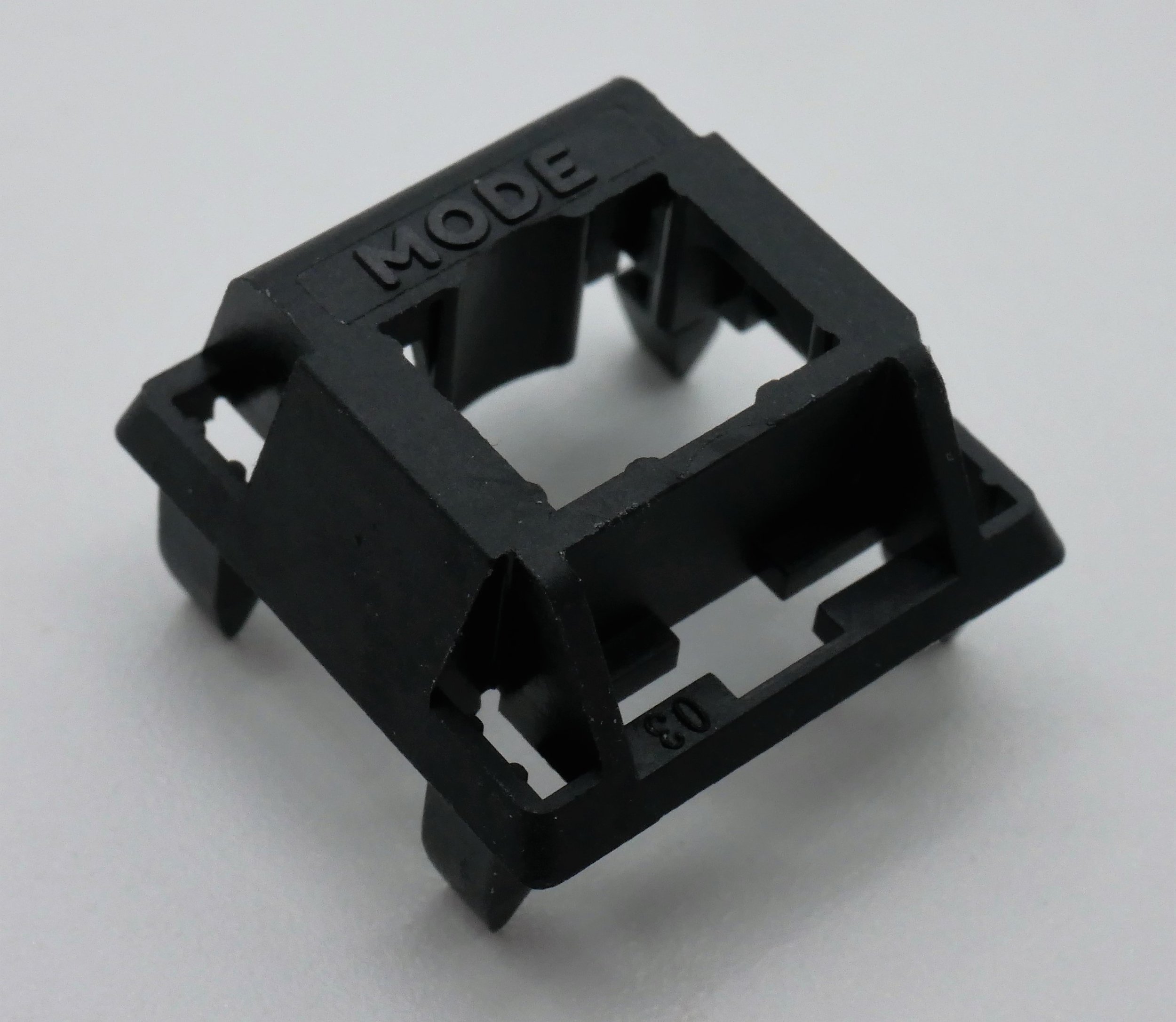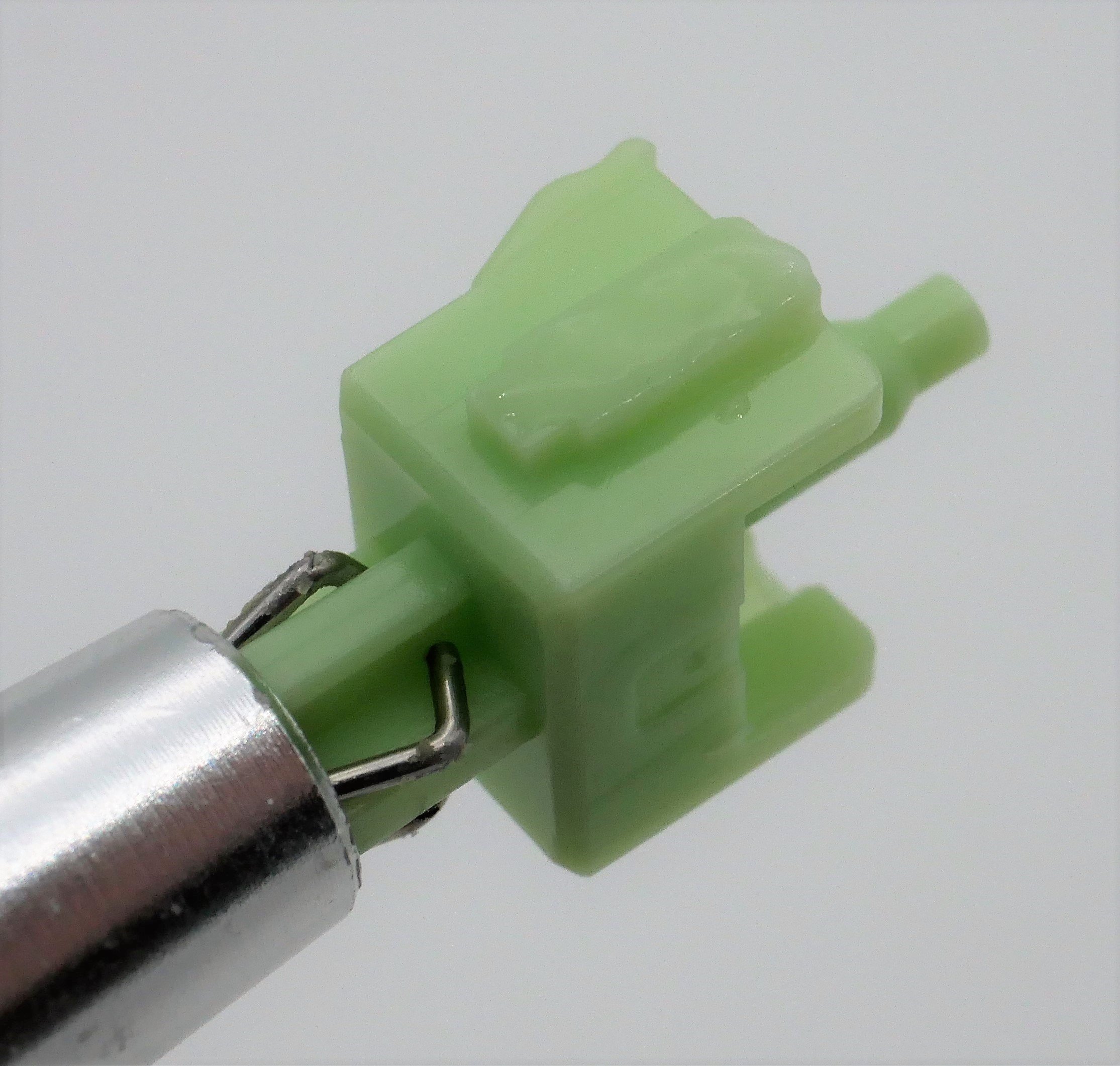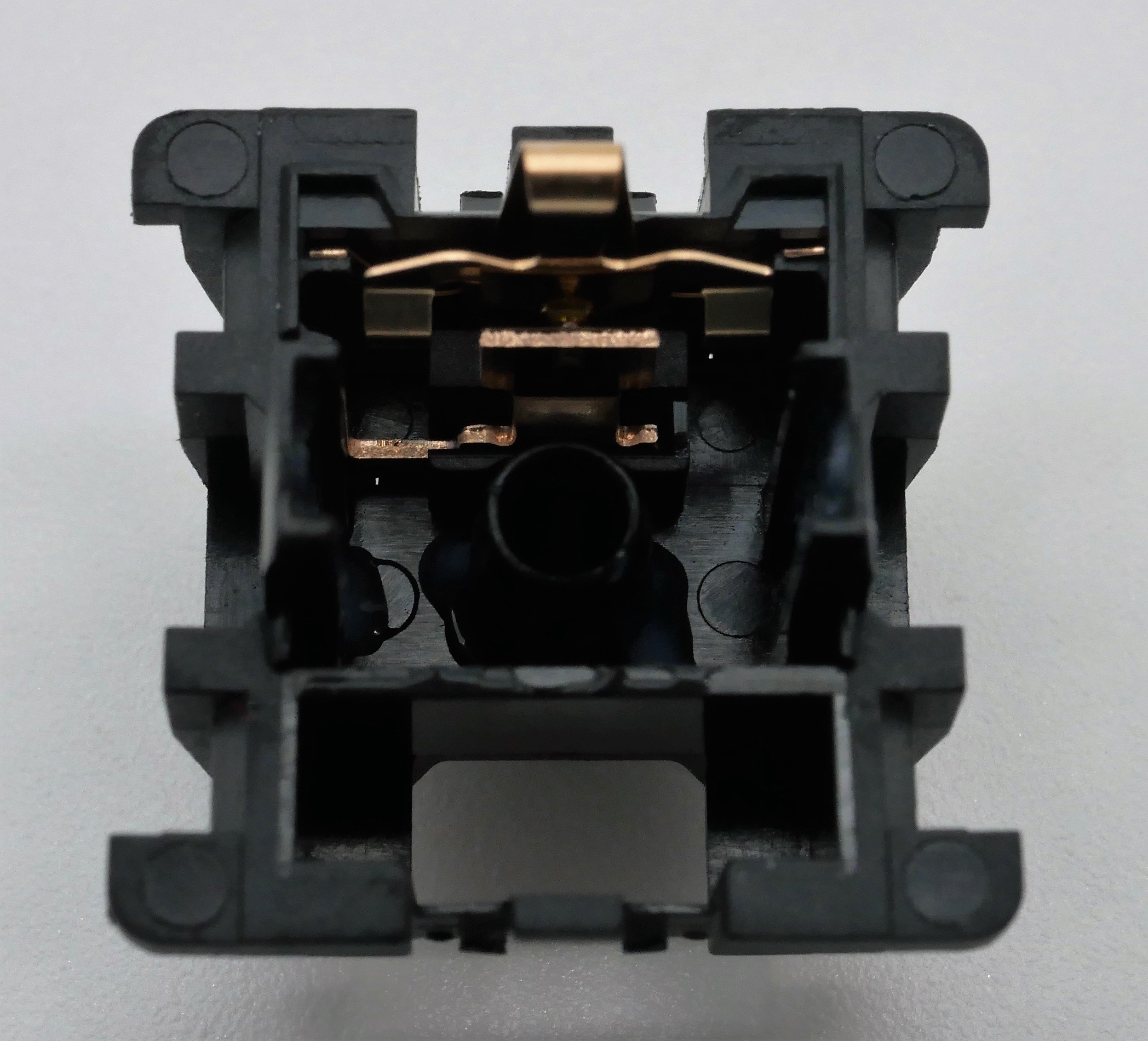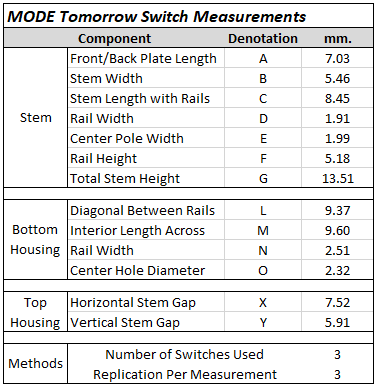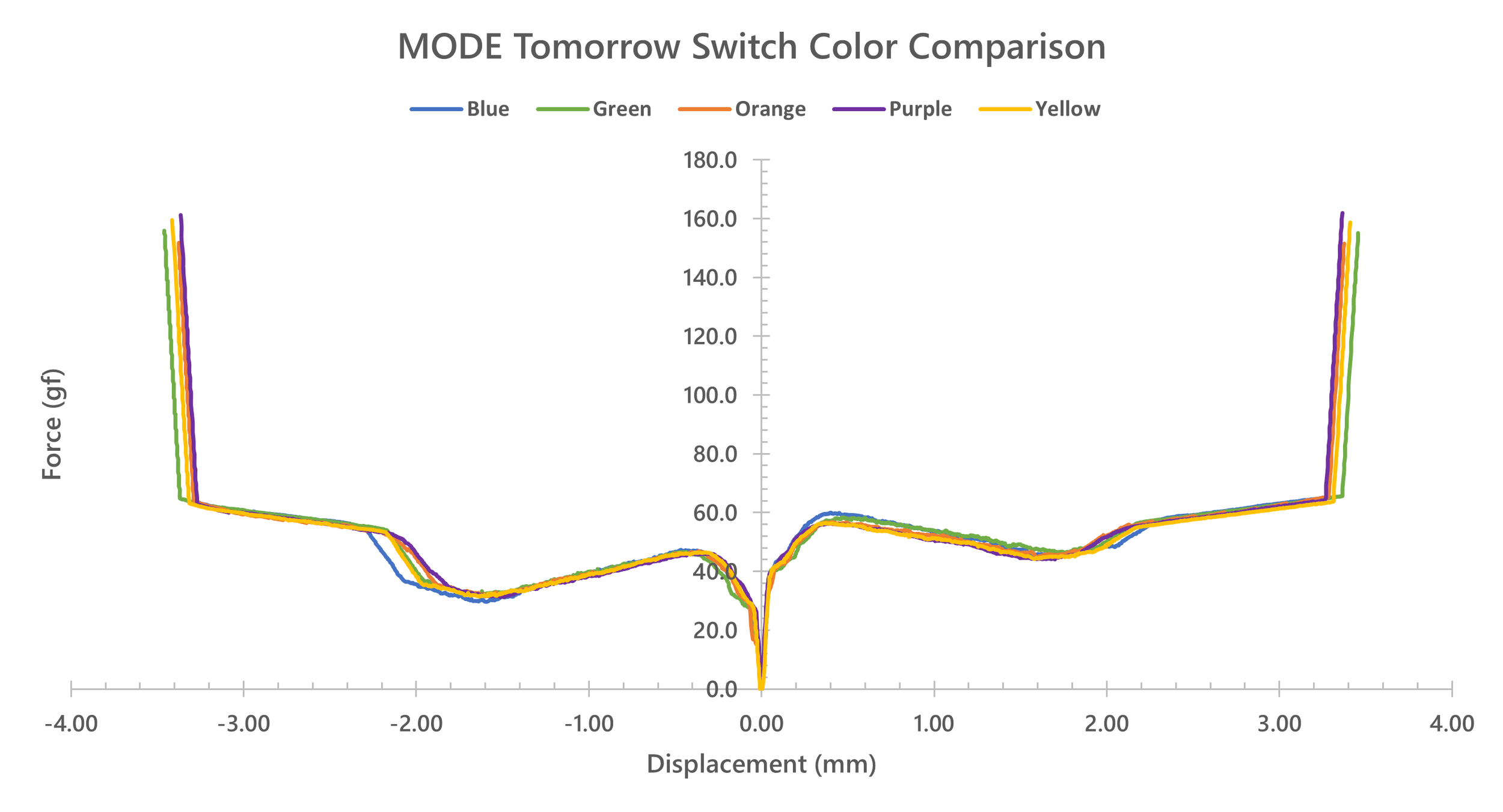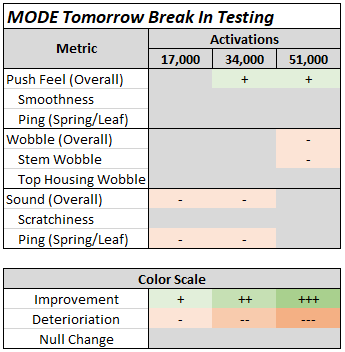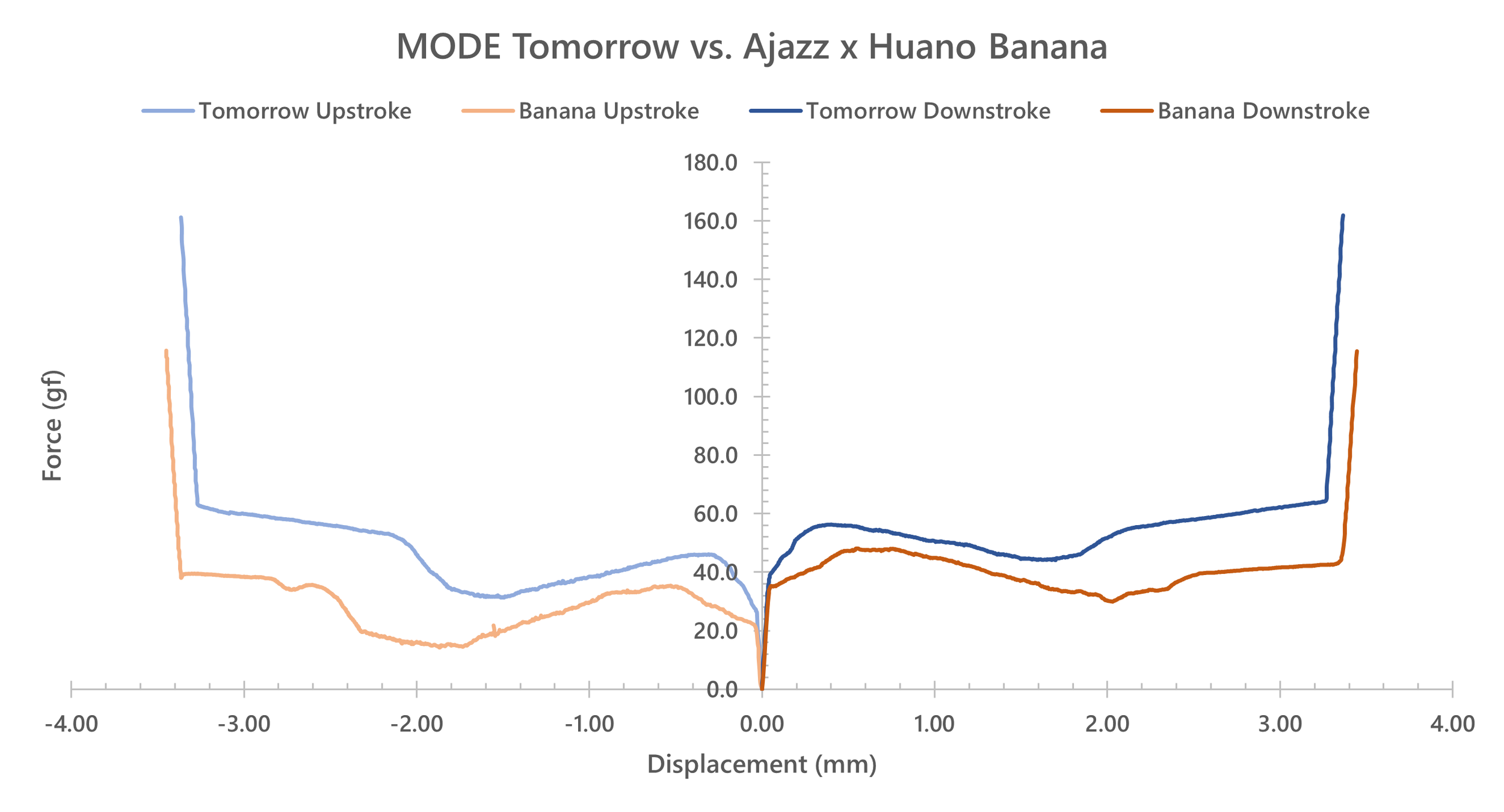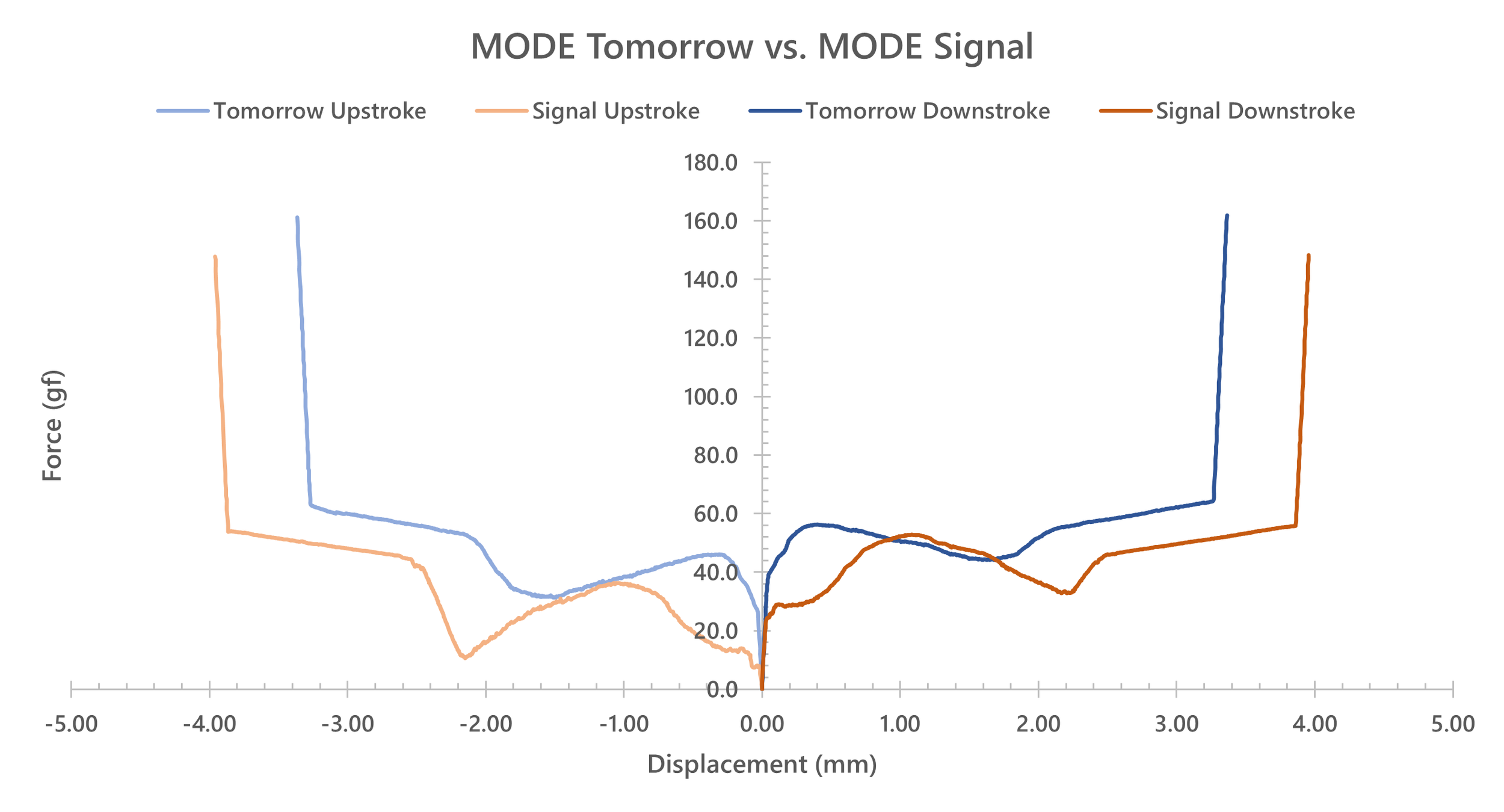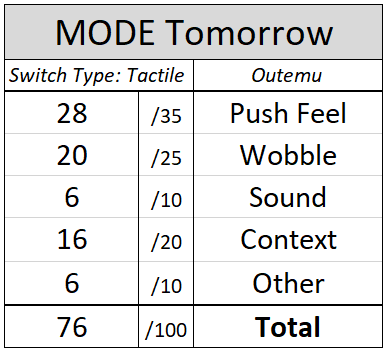MODE Tomorrow Switch Review
Is it really a true “cold open” if I start out the review with a meta fourth wall break?
For those of you who may have missed it in my Instagram and Twitter announcements last weekend, I’m very excited to be shuffling in ‘Shorts’ into my already way too large repertoire of content. Knowing full well that I’m doing this only so that I can further my writing and switch addictions simultaneously, these sporadically posted shorts will consist of brief articles around 1,000 words or so talking about anything related to switches, the website, etc. that I simply couldn’t work out into a full length article or review. While I currently only have one of these shorts up and ready to read as of the time of writing this review, I’ve already got quite a few in backlog ready to come out over the course of the upcoming months. Ultimately, I hope these will allow me to cover even more ground on switches than I already am while also keeping the writing fresh and exciting for me. (That is not to say that these normal length reviews are getting boring for me, either.)
As well, I should mention that this review is being done partly because I had some interest in reviewing these switches already, but an even larger part because my Instagram and Twitter followers voted for it! Yes, in an unprecedented manner I relinquished some level of control over my weekly 100,000 word writing exercises and had my supporters choose between the MODE Tomorrows and MODE Anthracite switches shortly after they were announced and some prototypes made it around to me. While I have to admit I was more partial to reviewing the Anthracites if the choice was solely mine, rest assured these are still definitely interesting enough to take a look. In the event I ever do a content-related poll such as these in the future I have to fully shill out by telling you to go follow me on those social media accounts. At the bare minimum you’ll get my relatively monthly AMA sessions on Instagram and me retweeting weird stuff from Japanese keyboard twitter.
Figure 1: I mean seriously, what are they doing over there?
Switch Background
MODE switches and I go way back. In my introductory shilling of social media accounts, you may have been able to pick up on the fact that I was interested in reviewing the Obscura, Anthracite, and Tomorrow switches as soon as their earliest teasers were announced. The reason that this is is because the original MODE Reflex and Signal switches, released all the way back at the beginning of 2020, were some of the first switches which I ever completed scorecards on. While their wording and look has since been changed in the Scorecard Update Project, the original scorecards dated as far back as February 21st of 2020, making them just shy of three years old at the time of writing this review. Given the opportunity to reflect on just how much switches as well as my own content have evolved over the past handful of years, I couldn’t help but jump at the opportunity to check these out.
Figure 2: I'm one thing borrowed away from a switch themed wedding here...
In order for a proper reflection, let’s take a quick time machine back to the start of 2020 to explore what the Reflex and Signals were like. Completely disregarding that this means our time machine breaks down at the very start of lockdowns and peak of toilet paper-lessness, it was a relatively exciting time for new keyboard switches as a whole. With the Stealios Controversy having exploded only three or four months prior in November of 2019, many vendors had begun moving past this drama spike and reaching out to this new, mysterious manufacturer in order to get switches made. While MODE was neither the first nor certainly the last vendor to reach out to Durock/JWK in order to get switches made, the announcement of the Reflex and Signal duo was the first solely keyboard design-focused company to brand and stock their own in-house keyboard switches. Sure, other vendors such as TKC, PrimeKB, and a few others sought out switches of their own from Durock/JWK prior to the MODE Signal and Reflex, though these companies all dabbled in switches in one fashion or another prior.
Coming as a tactile and linear duo, the Reflex and Signal switches were stocked as beginner friendly options that could be added alongside board purchases, such as their then recently released MODE 80, in order to have a nearly complete build show up at your door. As well, the clean and polished packaging design really did help push the appeal of these switches as fairly high quality options for not much more than you’d already be spending in cart. Noting that I may be entirely wrong in how I read this, the switches seemed to be a fairly strong plan on MODE’s behalf given that the MODE 80 advertising I recall at the time was slanted a bit more towards beginner-friendly audiences than most. While this duo of MODE switches didn’t appear to catch insane amounts of attention in the wider community at large, the fact that they remain in stock as of the time of writing this review certainly does speak to the fact that they’ve had some level of success over the past three years.
Figure 3: Original MODE Reflex and Signal packaging bag front and back.
In terms of performance, the tactile Signal and linear Reflex switches were both fairly par-for-course for Durock/JWK both at the time of their release and even today after countless releases and designs from them. Scoring in at a 70 and 68, respectively, in my initial scorecards of them, the Reflex and Signal switches both boasted an average amount of stem wobble, decent amount of factory lubing, and a pair of housing collisions that made for an alright typing experience. Whether or not people are willing to accept the reality of this statement given how much people have complained about Durock/JWK switch releases over the years, this is more or less the quality that the brand was built on and has stuck with over the past few years. While I don’t think the Signals, Reflexes, nor other Durock/JWK switches have dipped in their quality over the years on their own, it’s hard to look at the current state of switches at the very start of 2023 and say that the playing ground is quite the same as it was back then.
Keeping up with the times, in November of 2022, MODE began making announcements for a new line of switches that were being designed and stocked in-house in a similar fashion to the original Signals and Reflexes. Unlike that initial duo, though, the marketing, design, and manufacturing surrounding these were something else entirely different. Unlike the standalone releases that were the Reflex/Signal switches, MODE announced their Obscura, Anthracite, and Tomorrow switches all as one portion of a new “themes” package, centered around decking out your entire desk with the same aesthetic all from a singular design scheme and vendor. In addition to the switches baring the names of the themes themselves, each theme contained keycaps, desk mats, metal artisan keycaps, wall art, and ‘digital art’ in the way of computer screen wallpapers all to supplement each other. Given that the majority of these products are still in preorder phase prior to the publishing of this review, it’s uncertain as to how well this fully immersive thematic product line will be.
Figure 4: MODE's 'Tomorrow' product theme.
Much more interestingly, as well, the manufacturer of the Obscura, Anthracite, and Tomorrow switches are something that would have been altogether unexpected back in 2020: Outemu. Even with the rise of new manufacturers and designers over the past few years, releases by Gazzew in that three year stretch have helped revitalize the Outemu branding into a competitive market counterpart in the custom mechanical keyboard switch scene again. Riding this success and ostensibly finding a good partnership with Outemu, MODE reached out to them in order to design and manufacture their newest line of switches to match their ‘themes’ packages. As a result, the tactile Tomorrow, silent tactile Anthracite, and linear Obscura switches were all born as some of first custom switches to reach the community from Outemu independently of Gazzew’s influences. While each of these three switch options follow their own niche marketing trends and information from here, I’m going to narrow in further on just the Tomorrow switches since they are the sole focus of this review. (If you don’t like it, remember that you asked for it.)
The MODE Tomorrow switches were introduced alongside the Obscura and Anthracite switches in November of 2022, with the initial sales batch being limited to 25,000 switches on a Black Friday (11/25) launch. Priced at $0.65 per switch in bags of 70, 90, and 110, the Tomorrow switches are a 62g bottom out, long-pole tactile switch coming from Outemu lightly factory lubed and wearing the updated ‘MODE’ nameplate. While it is assumed that they will be stocked for quite some time moving forward given the Reflex and Signal’s presence in the MODE offerings for going on three years now, I have not heard any statements regarding long term plans. As well, I’m also unaware if these will supplement the Reflex/Signals or eventually phase them out altogether.
Tomorrow Switch Performance
Note: Having received original prototypes of the MODE Tomorrow, Anthracite, and Obscura switches and enjoying them, I had made my intentions clear to the company that I wanted to review one of these switches upon their release. After having allowed my social media team to vote on which one I reviewed, the switches were sent to me by MODE along with a sample of the Tomorrow deskmat. The review was not paid for in any capacity nor was MODE made aware of any of the contents prior to publishing.
Appearance
At the highest level, the MODE Tomorrow switches come in an all-black nylon housing design with one of five different colored POM stems – Orange, Green, Blue, Yellow, or Purple. The stem colors are entirely aesthetic choices and neither intentionally nor unintentionally alter the functionality of them. As such, they come in packs in a randomly mixed quantity of each color. Further high-level features of these switches prior to breaking down their individual component appearances is that of 205g0 lubing from the factory, PCB mounting pins, and dark grey/black colored springs around 14.60 mm in total length.
Figure 5: MODE Tomorrow switch and its components.
Looking first to the top housings of the MODE Tomorrow switches, the first immediate feature which stands out is that of the raised text ‘MODE’ nameplate on the four pin top housings. Secondary to that is the ‘plus shaped’ LED hole that has been commonly associated with Outemu-made switches in previous Gazzew and factory-based releases as well. In an interesting twist, rather than having the mold markings for the top housings on the interior features, the MODE Tomorrow switches feature an upside-down pair of double-digit mold markings in the bottom left-hand corner of the LED slot, as can be seen in Figure 6, below. Without this feature internally, there’s not much to comment on in the internal structure as the only details of note come in the form of mold ejector circles which can easily be seen in photographs.
Figure 6: MODE Tomorrow top housing external design showing 'MODE' nameplate, plus-shaped LED slot, and front, left corner double number mold marking.
Figure 7: MODE Tomorrow top housing internal design showing mold ejector circles and four pin attachment.
Moving next to the stems of the Tomorrow switches, as previously stated there appear to be no differences in the mold markings or overall design of the stems as a function of their color. All of the Tomorrow stems, though, clock in quite long in length at 13.51 mm long on average with untapered slider rails and a pretty strongly tiered center pole. While none of these features in and of themselves are particularly strange, there are design features on both the keycap stem mount and the backplate which certainly stand out as interesting. With respect to the backplate, centered on the bottom edge is a small, squared recess with what looks to be a mold injector mark which is a unique place for this design to be located. With respect to the keycap mounting stem, since there are no mold injector marks on this portion, each of the four posts is without a notch, something which is very commonly seen in switches from other manufacturers such as Gateron.
Figure 8: Front and backplate view of MODE Tomorrow stems showing their features as well as non-tapered slider rails and tiered center pole.
As for features of the stems which actually impact the overall feeling of the switches, there are a couple of points of interest to note. Firstly, MODE has informed me that they sent genuine 205g0 to Outemu to be used on these switches, and it primarily shows up only on the slider rails of the Tomorrow stems. While it may be a bit hard to see in Figure 9 below, it is more noticeable in the bottom housings upon opening the switches. Original prototyping phases of the Tomorrows sought to use a greater amount of a higher viscosity lubricant than 205g0, but was opted against because of the sluggish push feeling that it provided. As for the tactile bump, well I can’t really comment on that much from an appearance standpoint as it doesn’t particularly look like anything unique. The photos below should speak more than enough to this point.
Figure 9: MODE Tomorrow stem showing factory Krytox 205g0 lubricant application to slider rail.
Figure 10: Profile view of MODE Tomorrow stem showing tactile bump shape.
Finally reaching the bottom housings of the MODE Tomorrow switches, the most immediate feature to jump out at you upon opening these switches is the presence of 205g0 in the bottom housing interiors. Surprisingly well kept to just the slider rails and a little bit on the base of the bottom housing interior, the 205g0 appears to have been applied in a relatively precise fashion. Otherwise internally, mold ejector circles in the four corners of the upper rim as well as a pair in the base of interior are the only other real features of note. From the external side, the bottom housings feature a few characteristics which help identify them as Outemu-made, including the squared off LED slot as well as the double number, sideways mold marking to the right of this LED slot. As well, the design of the circular indentation around the metal PCB pins is ever so slightly different in shape than other manufacturers as can be seen below.
Figure 11: MODE Tomorrow bottom housing internals showing squared LED slot bottom, mold ejector circles in base and upper rim, and slight amounts of factory lubing on slider rails.
Figure 12: MODE Tomorrow bottom housing externals showing off square-like LED slot bottom, double number mold marking, and PCB mounting pins.
As a rather fascinating and completely unnecessary detail to point out, the prototypes of the MODE Tomorrow switches which I received are actually slightly differently colored than those of the release switches. While it is pretty impossible to tell the difference visually from any real distance, up close one can see that the prototypes were dark greyish in tone whereas the release housings are distinctly black. Funny enough, this actually the opposite of the prototype/release difference that I had noted in my Harimau Switch Review, in which the top housings of the prototypes were black and the release versions were dark grey.
Figure 13: MODE Tomorrow prototypes (Front, Grey) and release switches (Back, Black).
Push Feel
Given the apparent monopoly that Gazzew has had on Outemu switches in the custom scene for some time now, the almost immediate logical comparison people will draw to the MODE Tomorrows is that of the U4T and U4TX switches. I say that this is a “logical” comparison in that logic is the only place where it holds true. In reality, the MODE Tomorrow switches are a bit on the lighter side of medium-strength tactility and feature a bump that feels like it starts a bit into the downstroke and occupies the vast majority of the stroke length after that. That is not to say, however, that there is linear pre-travel or a completely absent bottoming out from the long stem pole, either. Rather surprisingly, even with a long stem pole, reduced travel distance well below 3.500 mm, and without an ultra-heavy tactile bump, the main feeling in this switch is its tactile bump. In a much less abstract sense, it is a very wide and flat tactile bump that is noticeable but not nearly as forceful as one might anticipate.
Figure 14: MODE Tomorrow force curve. I chose specifically the purple one because purple is a pretty cool color, and I took force curves of all of them for comparison as you can see below.
As for the parts of the push feeling of this switch not related to the tactile bump, there is a bit of a mixed bag of results. While the tactile bump is definitely standout enough to help differentiate them from many other tactiles in many people’s mind, so is the scratch, and not necessarily because it is overwhelming either. In fact, the scratch that is present is extremely minimal and sporadic across the batch that I received, though it feels almost like rubbing two heavy weight pieces of paper together. No sandpaper, nor discussions of rocks or pebbles - it just feels like two smooth-on-smooth surfaces just not quite being perfectly smooth enough, which is a rare kind of scratch in and of itself. As mentioned above, the bottoming out is hardly noticeable as a long stem pole, reduced distance bottom out and occupies the least noticeable trait alongside some subtle spring/leaf ping that is more present in sound than in feeling.
Sound
While not particularly bad on any distinctive feature, nor bad in an overall sense, the sound profile of the MODE Tomorrows is probably my least favorite aspect about them. To lay out the details prior to inflecting my opinion, the tactile bump is fairly quiet and on the borderline of silent tactile/tactile and is sandwiched between two medium toned housing collisions that are fairly well balanced. Because of the long pole bottom out, the Tomorrows have some increased pitch at higher actuation speeds than at lower ones. And finally, the ‘flat scratch’ and ping feelings that I’ve mentioned above in the push feel section show up here as sounds with a little bit more presence, though by no means overwhelmingly. It is also worth noting that the Break In section below talks about how these features change with respect to break in time.
Now as for the opinion part of the sound, these don’t quite sound as refined and polished as I had perhaps expected at first. With Outemu being on top of their releases in the past year, as well as MODE going with a lubed and all-nylon housing configuration, I definitely think that I had anticipated a louder, more bass-heavy switch with the exception of the pitch rising with typing speed because of the bottoming out. Instead, the Tomorrows are much more subtle on nearly all of these fronts and carry a bit more of a raw characteristic to their sound, as if the nylon and POM used in the housings and stems, respectively, were just not processed to the same degree as some other switches built like this. I think that this point, alone, will actually be rather enticing to some people, and I genuinely think it does help them stand out from the crowd a bit in terms of their performance. However, it very much defied my expectations and certainly doesn’t fit my personal taste as it stands now. I have no doubt, however, that I will come back to these switches in time and that this sound profile could very much evolve my tastes like some of the less aggressive long pole tactiles to have come out since the Moyu Blacks.
Wobble
There really isn’t all that much to say in the way of stem wobble here. There is a very minor amount in both the N/S and E/W directions that almost certainly will not bother most users and likely will only be a problem to those particularly sensitive to wobble and using builds which enhance stem wobble. The consistency across the batch is good in this regard, as well, with only minor variations across the batch. For knowing what Outemu can do in terms of stem wobble, its kind of hard to give these a fair shake from my end, but they are definitely more than acceptable by broad community expectations at this point.
Measurements
If you’re into this level of detail about your switches, you should know that I have a switch measurement sheet that logs all of this data, as well as many other cool features which can be found under the ‘Archive’ tab at the top of this page or by clicking on the card above. Known as the ‘Measurement Sheet’, this sheet typically gets updated weekly and aims to take physical measurements of various switch components to compare mold designs on a brand-by-brand basis as well as provide a rough frankenswitching estimation sheet for combining various stems and top housings.
Figure 16: Force curve comparison for each of the MODE Tomorrow switch colors.
As can be seen by the force curve comparison made above, the only differences in feeling between each of the colors of Tomorrow switches is purely a function of production variation. Any changes that can be seen here are absolutely unable to be detected by testing in hand, and if you claim that they can be felt blindly I will literally come fight you in person.
The latest in the content-adjacent work that I’ve picked up, the new ‘Force Curve Repository’ is now hosted on GitHub alongside the Scorecard Repository and contains all force curves that I make both within and outside of reviews. In addition to having these graphs above, I have various other versions of the graphs, raw data, and my processed data all available for each switch to use as you please. Check it out via the ‘Archive’ tab at the top of this page or by clicking any of the force curve cards above.
Break In
Break In Notes
17,000 Actuations
- While definitely not falling in the realm of necessarily bad nor good, it’s worth noting that at 17,000 actuations that the tactile bumps of the Tomorrows felt slightly more dampened and subtle than their stock counterparts. I suspect that this may have something to with the factory lube settling in after this break in period.
- Whereas the presence of the tactile bump at 17,000 actuations decreased, there was a noticeable uptick in the amount of spring and/or leaf ping across all of the switches that I tried. It is worth noting, as well, that the appearance of such was not necessarily uniform in magnitude across this batch.
34,000 Actuations
- Even though the stock MODE Tomorrow switches, themselves, did not have a wide swing in variability of push feeling across the batch that I received, the switches broken out to 34,000 actuations did feel ever so slightly more uniform in the size and strength of the tactile bump. As well, much like with the 17,000-actuation set, the 34,000 actuation ones felt much more dampened and subtle than the stock versions.
- The same issue regarding the spring/leaf ping in the 17,000-actuation set of switches is still present at 34,000 actuations and did not appear to significantly change in any real capacity.
51,000 Actuations
- The same notes above regarding the conformity and dampening of the tactile bumps of the Tomorrow switches over break in time also appear to hold true at 51,000 actuations and not significantly change.
- In a very strange sense, I had noticeably fewer switches in the 51,000-actuation batch which had spring/leaf ping sounds and I am uncertain if this is a function of the break in machine or simply random chance when pulling from the large batch that I received. While I personally feel that the latter reason is much more likely, I still felt the need to note it here in the event the spring/leaf ping in these switches actually does make a rebound with time.
Other
Figure 18: View of a 90 pack of MODE Tomorrow switches showing slightly altered design from the original Reflex and Signal packaging.
Much like the MODE Reflex and Signal switches before them, the MODE Tomorrow switches also come in similar shaped and style premium bags which make for great shelf display pieces. There are a few design differences such as the silver inner liner in the Tomorrow packages as opposed to the gold ones in the Reflex/Signal packages, as well as text and backside design features. However, regardless of whatever differences are present, the packaging is still fantastic and makes for a great package opening experience.
Comparison Notes to Other Notable Tactile Switches
Note – These are not aimed at being comprehensive comparisons between all factors of these switches as this would simply be too long for this writeup. These are little notes of interest I generated when comparing these switches to the Tomorrow switches side by
Figure 19: Switches for comparison. (L-R, Top-Bot: Lubed Invokeys Blueberry Chiffon, Gateron Holy Panda X, Ajazz x Huano Banana, Neapolitan Ice Cream, JWICK Taro, and MODE Signal)
Lubed Invokeys Blueberry Chiffon
- While both the Blueberry Chiffon and Tomorrow switches feature a subtle amount of scratch to them, the Blueberry Chiffon scratch is more small-grit sandpaper like whereas the Tomorrows have a ‘paper shuffling’ sort of scratch with no large grain nor variation across the stroke.
- The tactile bump of the MODE Tomorrow switches both packs a slight bit more tactile force to it as well as feels much more ‘large’. Looking at the force curve comparison below, it’s rather easy to see that the tactile bump of the Tomorrows feels this way as it simply takes up more of the total stroke distance than for the Chiffons.
- These two switches are similar in terms of overall volume. However, the sound of the Blueberry Chiffon switches is a bit more dampened and complex whereas the stock MODE Tomorrows are sharper, polished, and more singular in their housing collision sounds.
Gateron Holy Panda X
- Comparing the tactile bumps of these two switches, they feel surprisingly similar to one another with the exception of the Holy Panda Xs feeling as if they are a few grams more heavy at peak tactile force than the Tomorrows.
- With respect to stem wobble, the MODE Tomorrow switches are a bit more wobbly in both the N/S and E/W directions than the Holy Panda X switches.
- While the feeling of these two switches might be quite similar, their overall sound is significantly different. The Holy Panda X switches are louder than the Tomorrows and carry subtle higher pitched tones than that of the much more muted and bass-centric sound of the Tomorrows.
Ajazz x Huano Banana
- Even though the Ajazz x Huano Banana switches are noticeably lighter than the MODE Tomorrow switches, the first thing that comes to mind when testing these switches is just how much sharper and more pointed the bottoming out is of the Banana switches compared to the Tomorrows.
- With similar tactile bump lengths based on the force curve comparison shown below, it’s surprising that in hand the Tomorrows have a much more noticeable and distinct tactile bump. The Bananas, by comparison, almost feel as if they drag off a bit after their initial tactile peak.
- The stem wobble in the MODE Tomorrow switches is noticeably better in both directions than the Bananas.
Neapolitan Ice Cream
- The MODE Tomorrow switches definitely edge out the stock Neapolitan Ice Creams in terms of both their N/S and E/W direction stem wobble.
- In a similar comparison note as was made above for the Ajazz x Huano Banana switches, the Neapolitan Ice Creams have a significantly more pointed punch at the bottom out than the Tomorrows.
- While the force curve comparison below may belay to you that these two switches actually have fairly similar force curves, the Neapolitan Ice Creams both feel as if they are heavier and have a slightly more forceful tactile bump. To be entirely honest, I’m rather surprised about these differences given just how similar they appear to be by the data.
JWICK Taro
- While the JWICK Taro switches have a bit stronger peak tactile force than the MODE Tomorrow switches, they are the most similar to the Tomorrows with respect to their tactile bumps of any of these switches on this list.
- As well, the stem wobble between these two switches is probably the most similar out of any of the comparisons made on this list. This is with the exception of the E/W direction stem wobble where the Taro edge out the Tomorrows.
- In terms of sound, the JWICK Taro are both significantly louder than the MODE Tomorrows as well as pack a higher pitched topping out as a result of their polycarbonate over nylon housing design which becomes more evident with faster typing speeds.
MODE Signal
- In terms of a straight head-to-head comparison of the tactile bumps, the Tomorrows feel both stronger as well as ‘wider’ across the tactile bump if that makes sense. If the Reflex is driving on a single lane road, the Tomorrows feel like a multi-lane highway.
- Of all of the switches on this list, these two share the most similar sound as well as pitch.
- Whereas the wobble of the Signals certainly weren’t bad for the time in which they were released, the recent renaissance of Outemu and their mold designs have definitely led to the Tomorrows outclassing the Signals in terms of stem wobble.
Scores and Statistics
Note – These scores are not necessarily completely indicative of the nuanced review above. If you’ve skipped straight to this section, I can only recommend that you at least glance at the other sections above in order to get a stronger idea of my opinion about these switches.
Push Feel
Coming in with a just under medium-strength tactile bump, the MODE Tomorrows start early and have a rather long-running bump that occupies the majority of the downstroke until the very shortened bottom out is reached. While not overly forceful, it is definitely the star of the show between two medium firmness housing collisions and some subtle amount of thin scratch and leaf/spring ping that leave these switches with some slight room for improvement.
Wobble
Consistent across the batch, the MODE Tomorrows feature very little N/S and E/W stem wobble and are rather consistent about it across the batch that I received. While not quite pushing the absolute limits like Outemu can do, these are still fairly respectable all things considered.
Sound
Without a doubt, the sound is going to be the thing that make or break these switches for most people. While all-nylon, long stem pole, and medium tactility all conjure up a fairly solid picture in one’s mind, the Tomorrows are simply not that. They are more raw, more muted, and an altogether much more subtle sounding switch that many people could enjoy but few would expect.
Context
Priced at $0.65 per switch as a long in-stock option from MODE, a vendor which has carried the same custom switch offerings for over 3 years now, these check all the boxes for consistency, availability, and longevity in this category. The price per performance metric could be slightly better, and the pack size does make it a little hard for many newcomers to willingly try out these switches, but all things considered they’re an extremely solid offering outside of the package.
Other
The overall aesthetic design and implementation of these switches, while perhaps a bit overdone to a degree, is exciting and certainly uncommon to see from larger vendors as such.
Statistics
If you are looking at this statistics section for the first time and wondering where the hell are the other 216 switches that I’ve ranked are, or what ‘hard’ versus ‘soft’ ranks refer to specifically, I’d encourage you to head on over to my GitHub linked in the table above or at the links in the top right hand of this website to check out my database of scorecards as well as the ‘Composite Score Sheet’ which has a full listing of the rankings for each and every switch I’ve ranked thus far.
Final Conclusions
Going through this review and comparing the commentary and data collected here to back when I first reviewed the MODE Reflex and Signal switches, I feel as if I have aged significantly more than I should have in that span of time. Seeing vendors like MODE release switches that I remember collecting and have had sitting on a display shelf come back around years later to reconnect with a brand-new line of switches entirely from the ground up is an experience that I had considered would be a possibility for me. Given the relatively niche nature of keyboards and the small product creation volume than some larger hobbies which have content creators, I don’t think many reviewers of products get to have gaps of multiple years between similar product releases of small companies. Either that, or I think way too highly of this hobby. Either way, the actual performance of the Tomorrow switches has only further heightened my Twilight Zone-like fascination with how switches and this whole process of buying, reviewing, and collecting them has changed over the past few years.
Stepping up to the plate with a brand-new set of switches from Outemu, MODE really did quite a good job of narrowing in on a design for the Tomorrows which will sustain them and their customers for years to come while also still standing out amidst the backdrop of most tactile switch offerings. Do not get me wrong, these are far from world breaking revolutionary switches. These were very much targeted to be tactile switches that a vast majority of keyboard enthusiasts could appreciate and that could work in a large range of keyboards and settings. Just shy of medium strength tactility, sandwiched between semi-firm housing collisions and with pre-applied 205g0 lubing, the Tomorrows do exactly that. What was probably the most interesting of the performance metrics for the Tomorrows though, good or bad, was that of how far outside of my expectations the sound showed up. Even with all nylon housings, a strong enough tactile bump to induce some level of ping, and a reduced travel distance as a result of a long stem pole, these still carry a low volume that is subtle and without much undertones as opposed to the louder, bass-heavy sound one would expect from that configuration. It may be far from the record books, but the MODE Tomorrows sure can pitch one interesting experience that is worth checking out if you are searching for some variety in your tactile switches.
Figure 28: Ha, get it? Pitch.
Sponsors/Affiliates
Mechbox UK
- A wonderful UK based operation which sells singles to switches that I’ve used above in my comparisons for collectors and the curious alike. Matt has gone out of his way to help me build out big parts of my collection, and buying something using this link supports him as well as my content!
KeebCats UK
- A switch peripheral company based out of the UK which sells everything switch adjacent you could ask for, they’ve been a huge help recently with my film and lube supply for personal builds, and they want to extend that help to you too. Use code ‘GOAT’ for 10% off your order when you check them out!
proto[Typist] Keyboards
- An all-things keyboard vendor based out of the UK, proto[Typist] is a regular stocker of everything from switches to the latest keyboard and keycap groupbuys. While I’ve bought things from the many times in the past, they also are a sponsor of my work and allow me to get some of the great switches I write about!
MKUltra Corporation
- We may have stolen a few government secrets to get this one together. MKUltra is a US vendor that truly fills all the gaps other vendors simply don’t offer and is continuing to expand their switch and switch related peripherals by the day. Use code ‘GOAT’ for 5% off your order when you check them out!
Divinikey
- Not only do they stock just about everything related to keyboards and switches, but they’re super friendly and ship out pretty quick too. Divinikey has been a huge help to me and my builds over the last year or two of doing reviews and they’ll definitely hook you up. Use code ‘GOAT’ for 5% off your order when you check them out!
ZealPC
- Do they really need any introduction? Zeal and crew kicked off the custom switch scene many years ago with their iconic Zealios switches and the story of switches today couldn’t be told without them. Use code ‘GOAT’ (or click the link above) for 5% off your order when you check them out!
MechMods UK
- A rising vendor based in the UK, Ryan and crew have been a pleasure to work with and have nearly everything you’d need to build your first or fourteenth keyboard. Go build your latest or greatest one right now with them by using code ‘GOAT’ at checkout for a 5% discount!
Dangkeebs
- A longtime supporter of the website and the collection, Dangkeebs has quite possibly the widest variety of switches of any vendor out there. Not only is their switch selection large, but it rotates and is constantly adding new stuff too. You’re going to need 5% off your order with my affiliate to save off the cost of all those switches!
SwitchOddities
- The brainchild of one my most adventurous proxies, SwitchOddities is a place where you can try out all the fancy, strange, and eastern-exclusive switches that I flex on my maildays with. Follow my affiliate code and use code ‘GOAT’ at checkout to save 5% on some of the most interesting switches you’ll ever try!
Cannonkeys
- Does anybody not know of Cannonkeys at this point? One of the largest vendors in North America with keyboards, switches, keycaps, and literally everything you could ever want for a keyboard always in stock and with an incredibly dedicated and loving crew. Follow my affiliate link above in their name to support both them and I when you buy yourself some switches!
Kinetic Labs
- One of the most well-rounded keyboard vendors out there, Christian and crew have been supporters of all my switch and switch-adjacent needs for some years now. I’m honored to have them as an affiliate and think you should check them out using my affiliate link above to support both them and I when you check out their awesome products!


